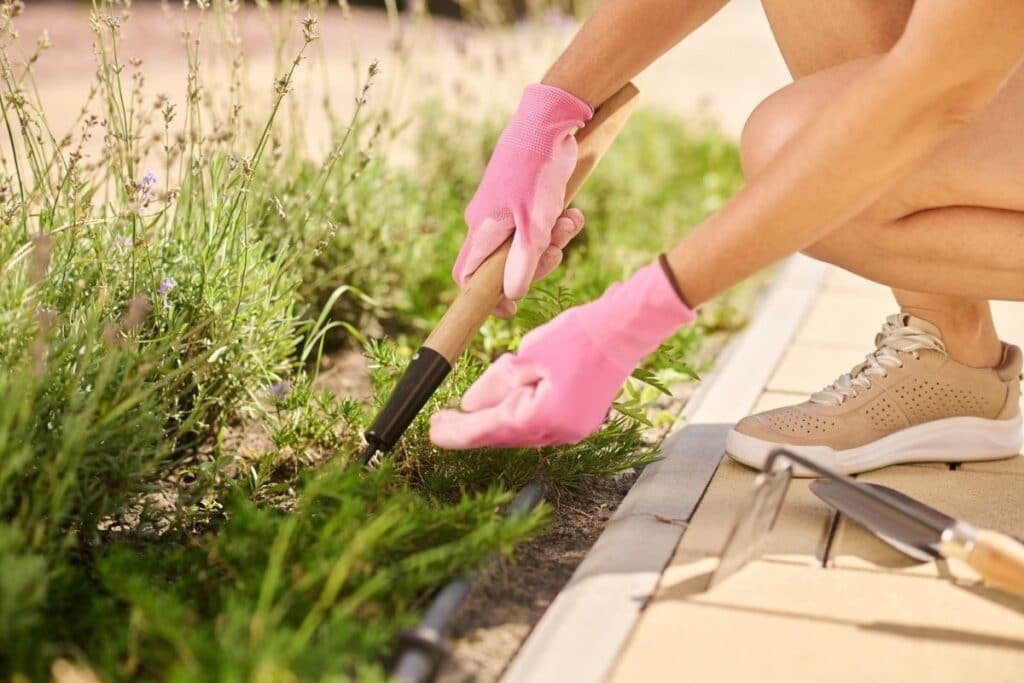Want to learn how to keep weeds out of the garden? Believe it or not, it can be done.
Anyone with experience in the garden knows that gardening is just another word for weeding. In other words, weeding is just part of the gardening process. There is little you can do to avoid weeds altogether. However, there is plenty that you can do to mitigate how frequently the weeds grow and in what areas they put down roots.
If you are struggling with weeds in your yard, look no further. Below you will find a comprehensive guide that focuses on ten tips you can try out to mitigate weed growth in your garden.
What Causes Weeds in the Garden?
Weeds grow in the garden for all the same reasons your fruits and vegetables grow. They are opportunistic plants that take advantage of favorable growing conditions like temperature, soil moisture, nutrients, and minerals.
If there is space for all the weeds to grow, along with sunlight, water, and productive soil, they will thrive. When weeds flourish, they can produce thousands of seeds per plant, further perpetuating their presence in your garden. There are three types of weeds:
- Annual Weeds: these weeds spread by setting their seed and germinating quickly, only growing for a single season before dying off.
- Biennial Weeds: biennial weeds live for two years. In the first year, the weed seed germinates and produces a leafy plant. In the second year, the plant flowers and spreads its seeds.
- Perennial Weeds: these weeds grow for multiple seasons. They spread by setting seeds and growing from their roots.
How Do You Stop Weeds from Growing in Your Garden?
Stopping deep rooted weeds from growing in the garden is an ongoing project. It requires a ton of patience and perseverance. However, over the years, we have followed these five essential rules to keep weed growth at bay.
- Every spring, only till the garden soil when necessary, and avoid over tilling not to spread dormant weed seeds.
- Practice companion planting to create a dense allotment of plants and shade out existing weeds.
- Always mulch around your plants to suppress weed growth and cut off weed seeds from sunlight and water.
- Spend time in the garden weeding every day of the growing season.
- Plant cover crops during the winter, or cover the area with landscape cloth or plastic.
Below you will find some additional tips to follow these five rules. Keep on reading to learn about some of the tactics we employ in our gardens to keep those pesky weeds from taking over.

What Is The Best Way to Get Rid of Weeds?
When you remove weeds, you want to ensure that you are not damaging other parts of your garden. To do so, you need to be careful with how you weed, when you weed, and which garden tools you use (or don’t use).
There’s no one single perfect solution when it comes to controlling weeds. However, you can learn how to kill weeds without killing other plants and flowers.
1. Avoid Over-Tilling the Soil in the Spring
Tilling the soil is essential for aerating it and preparing it for new plants. However, tilling is also notorious for embedding the hidden weed seeds deeper into the soil. Once the weeds have been replanted, they’ll begin to germinate after your first watering. So we recommend you avoid over-tilling the soil. If you can, avoid using a machine.
2. Mulch Your Garden Beds
Mulch is one of the most effective ways you can keep weeds out of flower beds. Mulch suppresses weed growth because it creates a barrier between the weed’s seeds in the soil and the sunlight. If the seeds cannot access water and sunlight, they will not germinate and grow.
There are many different types of organic mulch. Wood chips, newspaper, gravel, grass cuttings, and fallen leaves are all fantastic options for mulch.
Besides suppressing weed growth, mulch is also useful for retaining soil temperatures, protecting delicate and shallow roots, and protecting against erosion. Incorporating organic matter into your garden beds through mulch provides multiple benefits for your plants and soil health.
3. Grow Plants Close Together
Growing plants close together, otherwise known as companion planting, is a good way to control the number of weeds that grow in your garden. Planting a dense garden of plants means less room in the soil for weeds to grow.
It’s difficult for weeds to compete for soil and sunlight when there are larger plants taking up garden space. So for the few weeds that do pop up, simply pick them out by hand. Over time, as your plants mature, you’ll notice fewer weeds because there will be no real estate for them to make a home.
Before we plant our garden, we love drawing up a map of the garden plot. That way, we can predetermine what will go where and how to most effectively use the space.
4. Inspect Your Store-Bought Plants for Hitchhikers
We all love supporting local businesses and purchasing plants from our local nurseries and garden centers. That said, we don’t love the hitchhiking weeds that come with those plants.
Whenever you purchase plants from a nursery, always make sure to inspect your plant specimens for hitchhiking weeds. Then, you can pluck them out ahead of time and not have to worry about them taking root in your garden after you’ve taken them home.
5. Water Your Plants Strategically
When you water your plants, you do not have to water the entire place. We do not recommend that you simply broadcast water everywhere or let the water run throughout the garden without supervision. When you do that, you may be inadvertently watering weeds.
Instead, when it’s time for watering, we recommend you do so with intention. Use the soaker mode on your hose faucet, and water your plants from the base. Soaking the plants at the base instead of watering them from the top down will allow you to better control where the water goes. Plus, watering the plants at the base spreads less plant disease.
6. Get Used to Hand-Weeding
Pulling weeds out by hand for a gardener is like typing on a keyboard for a writer. You just have to get used to doing it every day. Whether you like it or not, hand weeding is the bread and butter of home gardening.
Hand weeding using your hands or a hand weeder such as a hori hori knife is a great way to keep weeds out of the vegetable garden and flower beds. Because you can identify and pick the weeds out, it’s the most effective method that kills weeds but not flowers and plants.
To get used to hand-weeding, we recommend you try to spend time in your garden every day. The more time you spend, the better. With time, you’ll be able to stay on top of weed growth and notice new growth and pull weeds out before they have time to develop fully.
7. Plant a Cover Crop
For whatever reason, sometimes, there are areas in our gardens that are not currently being cultivated. So you shouldn’t just leave the soil bare. It’s better to plant a cover crop.
Cover crops are low-maintenance and fast-growing plants. They help enrich the soil and prepare it for the next crop. Plus, their presence in the soil makes it more difficult for weeds to grow.
8. Regularly Apply Spot Treatments
To control weed growth, you may need to apply treatments of weed-killing products occasionally. We recommend you only apply these products in the specific areas that are needed. Avoid broadcasting the spray treatment into other sections of the garden. To do so, try not to spray your weed-killer during windy days. Only use this method to eliminate weeds when necessary.
9. Use Landscape Fabric or Black Plastic
Installing a weed suppressant such as weed mat, landscaping fabric or black plastic is a fantastic way to prevent weeds in your garden bed. However, it is one of the more work-intensive and expensive weed control tactics you can try and it’s also the best way to keep weeds out of the garden.
Landscape fabric covers the ground, cuts off the soil from water and sunlight, and suppresses weed growth. Before planting, you can cover your beds in landscape fabric and then create holes where your plants will grow. It will be much harder for weeds to grow in the covered areas.
Landscape fabric and black plastic are also common tactics to ensure weeds do not grow over the winter. Additionally, consider using raised beds for your plants—they provide better drainage and can help prevent weed intrusion.
10. Don’t Allow Weeds Go to Seed
If a weed goes to seed before you get to it, you may be dealing with weeds from that singular weed for years to come. That is why it’s so important never to let weeds mature enough for them to go to seed. If you keep a regular weeding routine, this will probably never be a problem. However, even the most avid gardeners miss a week or two every now and again.
Don’t forget, as weeds mature, you can use them to your advantage. Larger weeds can be chopped out of the ground and used as biodegradable material to help enrich the local soil or compost pile.
Learn to Love Garden Weed Control
There would be no weeds sapping the valuable nutrients from our soils in a perfect world and shading out smaller plants. Then again, in a perfect world, our beloved plants would grow themselves, right?
Unfortunately, whether we like it or not, weeds are a part of gardening. You cannot have one without the other. All you can do is mitigate the intensity in which seeds try to take hold of the vacant spaces in your garden.
With time, a lot of patience, and the weeding tips from above, you ought to be reaching a semi-weed-free state in no time. Learn to love weeding! We know you can.
FAQs
How do you permanently stop weeds from growing?
To permanently stop weeds from growing, use a combination of strategies including mulching, hand-pulling, using weed barriers, and applying herbicides selectively. Regular maintenance and prevention methods such as proper watering and soil cultivation can also help prevent weed growth over time.
Which is the most common weeds in vegetables?
The most common weeds in vegetable gardens vary depending on the region and growing conditions, but some common examples include crabgrass, dandelions, chickweed, purslane, and pigweed.
What is the best plant to stop weeds?
Ground cover plants like clover, vetch, or low-growing perennial herbs such as thyme or oregano can help suppress weed growth by shading the soil, competing for nutrients, and inhibiting weed seed germination. Additionally, dense plantings and proper spacing of vegetable crops can help reduce weed competition.
What kills weeds permanently naturally but not grass?
Natural methods to kill weeds permanently without harming grass include using organic herbicides like vinegar, boiling water, or homemade solutions containing ingredients like salt or citrus oil. These substances can be applied directly to weeds to kill them without affecting surrounding grass or desirable plants. However, it’s important to use these methods carefully and selectively to avoid damage to desired vegetation.
See more: How to keep grass out of flower beds
*image by goffkein&Dmyrto_Z/depositphotos







